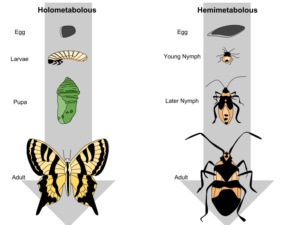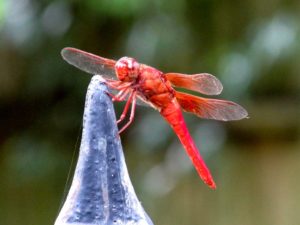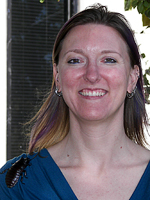.

In both metamorphosis stages, the insect begins the cycle as an egg. In a complete metamorphosis the insect passes through four distinct phases which produce an adult that does not resemble the larvae. An incomplete metamorphosis means the insect does not go through a full transformation, but instead transitions from a nymph to an adult by molting its exoskeleton whenever it becomes too tight.
Two Categories of Insect Lifecycles
Wizzie is kicking off the year with some basic insect biology about metamorphosis.
Insect life cycles can be broken down into two major categories: incomplete and complete. Incomplete can then be further broken into three varying types.
Paurometabolous
Incomplete metamorphosis, also called paurometabolous, has three life stages. The first stage is the egg which hatches into an immature insect called a nymph. The nymph eats, grows and molts, going through several different nymphal stages called instars. With each successive molt, the nymph grows larger and begins to develop wings. Nymphs look similar to adults in appearance with the exception that they do not have fully developed wings. The final stage is the adult which has fully developed wings (of course, unless the insect is wingless i.e. bed bugs). Adult insects seek out the opposite sex, mate, and females lay eggs to begin the cycle anew. An example of an insect with paurometabolous metamorphosis is a cockroach.
Ametabolous
Primitive insect groups have a variation of incomplete metamorphosis called ametabolous. This type of metamorphosis also has three life stages: egg, nymph, and adult, but the immatures/ nymphs look exactly like the adults except they are smaller in size. Dissection may be needed to tell immatures from adults. An example of an insect with ametabolous metamorphosis is a silverfish.
Hemimetabolous

A dragonfly is an example of hemimetabolous metamorphosis
The second variation of incomplete metamorphosis is called hemimetabolous and insects with this type of metamorphosis have an immature stage that is aquatic. Again, there are three life stages: egg, nymph, and adult. The nymphal stage of hemimetabolous insects lives in water and is called a naiad. The last nymphal instar- or the last stage before the insect molts into an adult- crawls out of the water onto a dry surface so the adult insect can emerge without getting their wings wet. An example of an insect with hemimetabolous metamorphosis is a dragonfly.
Complete Metamorphosis
The second basic category of metamorphosis is complete, or holometabolous, metamorphosis.
Complete metamorphosis has four life stages: egg, larva, pupa, and adult. Eggs are laid by fertilized adult females and hatch into the second stage called a larva. Larva* look very different from the adults and often feed on different food sources than adults. Larva are often have elongated bodies, no wings, and may or may not have legs. After going through several instars, or larval stages, the insect turns from a larva into a pupa. The pupa is a transformation stage for the insect where it rearranges it’s body into the adult form. Sometimes you can see adult features in the pupal stage, but other times the pupa is within a case- like with fly or butterfly** pupa- and you cannot see development. The adult insect emerges from the pupal stage, seeks out a mate for mating, and continues the cycle.
*Larva is the general name for immature insects that go through complete metamorphosis. There are more specific names for various types of larva based on what Order they belong to.
Larva in the Order Lepidoptera that turn into butterflies and moths are caterpillars. Larva in the Order Diptera and turn into flies are maggots. Also in the Order Diptera, wigglers are the larval stage of mosquitoes (and mosquito pupae are often called tumblers). Larva that turn into beetles, Order Coleoptera, are called grubworms or wireworms (depending upon what type of beetle they turn into).
**A butterfly pupal case is called a chrysalis.
For more information or help with identification, contact Wizzie Brown, Texas AgriLife Extension Service Program Specialist at 512.854.9600.
Additional Resources
About Wizzie

Wizzie Brown
County Extension Program Specialist – Integrated Pest Management
Email:EBrown@ag.tamu.edu
Wizzie has been with Texas A&M AgriLife Extension Service since 2002 and has been playing with insects since she was a toddler. She is an Extension Program Specialist with the Integrated Pest Management (IPM) program. Wizzie holds a B.S. in entomology from The Ohio State University and a M.S. in entomology from Texas A&M University. The integrated pest management program provides identification, biological and management information to whomever needs help. Wizzie’s research focuses on imported fire ants, including community wide fire ant management. Wizzie also is happy to provide programs to area groups on a variety of arthropod-related topics. You can find insect and other arthropod information on Wizzie’s blog.

